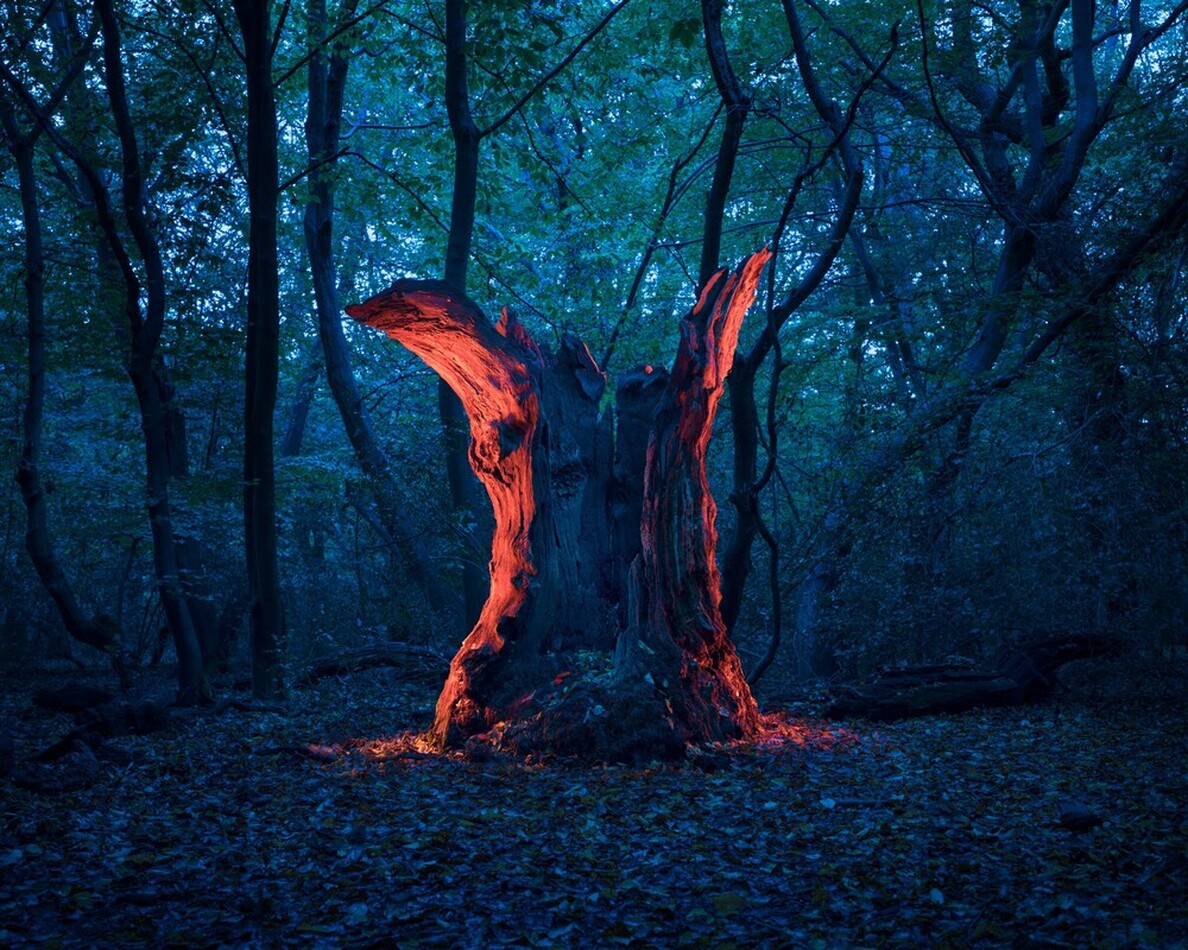Grete Hjorth-Johansen
Cronus, from the series TARTARUS, 2020 - Photographic archival giclée print, framed. Edition of 5+2AP
90 x 115 cm - £1,750.00
My series Tartarus, shot in Epping Forest, looks at the old, dying pollards and reimagines them as ancient Greek deities who were thrown into Tartarus, the place of torture in the Underworld.
The trees gained their odd, hollow shapes from the scarring of repeated cutting for the timber trade, much like the Greeks used the idea of futile repetition of a task as a means of torture.
By lighting the trees in jewel tones, I make them stand out and stand proud in their final days in the forest.
In ancient Greek mythology, Cronus was a Titan, in other words, a giant of great power and strength. He was banished to Tartarus along with his other Titan siblings by his father, Uranus, who felt they were a threat.
Cronus was a patron of the harvest, and he is often depicted with a sickle. It was the curved shape of the sickle that made me think of Cronus, as well as the huge size of the hollow tree trunk.
90 x 115 cm - £1,750.00
My series Tartarus, shot in Epping Forest, looks at the old, dying pollards and reimagines them as ancient Greek deities who were thrown into Tartarus, the place of torture in the Underworld.
The trees gained their odd, hollow shapes from the scarring of repeated cutting for the timber trade, much like the Greeks used the idea of futile repetition of a task as a means of torture.
By lighting the trees in jewel tones, I make them stand out and stand proud in their final days in the forest.
In ancient Greek mythology, Cronus was a Titan, in other words, a giant of great power and strength. He was banished to Tartarus along with his other Titan siblings by his father, Uranus, who felt they were a threat.
Cronus was a patron of the harvest, and he is often depicted with a sickle. It was the curved shape of the sickle that made me think of Cronus, as well as the huge size of the hollow tree trunk.
I am a London-based Norwegian photographer, working on both commissioned and fine art projects.
My artistic background stretches from mural painting to graphic design and later VJing for the biggest names and venues in dance music.
I have previously taught photography and darkroom techniques at various colleges.
Bridging the gap between photographic and painterly aesthetics, I use a vibrant colour palette of lighting to explore and describe the moods, emotions and atmospheres that I experience around me.
Love, grief, melancholy and anger are all recurring themes. Rather than documenting reality as it appears naturally, I aim to let my inner world spill its colours onto the surfaces of the simplest shapes, the mundane, the familiar.
Using lighting as paint brushes, I aim to explore the shapes and textures of everything from vegetables to trees, turning them into otherworldly creatures and deities.
In my series Tartarus, the old, pollarded trees of Epping Forest have caught my imagination as I explore the pained expressions that emerge once the trees are lit and isolated – almost like sculptures in a gallery.
Pollarding – the repeated cutting of timber – damages the trees until they die, hollow, contorted and exhausted.
My artistic background stretches from mural painting to graphic design and later VJing for the biggest names and venues in dance music.
I have previously taught photography and darkroom techniques at various colleges.
Bridging the gap between photographic and painterly aesthetics, I use a vibrant colour palette of lighting to explore and describe the moods, emotions and atmospheres that I experience around me.
Love, grief, melancholy and anger are all recurring themes. Rather than documenting reality as it appears naturally, I aim to let my inner world spill its colours onto the surfaces of the simplest shapes, the mundane, the familiar.
Using lighting as paint brushes, I aim to explore the shapes and textures of everything from vegetables to trees, turning them into otherworldly creatures and deities.
In my series Tartarus, the old, pollarded trees of Epping Forest have caught my imagination as I explore the pained expressions that emerge once the trees are lit and isolated – almost like sculptures in a gallery.
Pollarding – the repeated cutting of timber – damages the trees until they die, hollow, contorted and exhausted.

